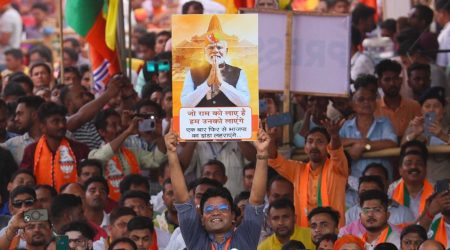Holi, with its lively colors and festive spirit, unites people in a joyful celebration of unity and bliss. Throughout India, it is celebrated with diverse customs and the celebrations go beyond just colors. The South Asian Times explores unique ways this vibrant and joyous festival is celebrated across India.
Lathmar Holi | Uttar Pradesh

Also known as the Holi of sticks (lath), it is celebrated in the towns of Barsana and Nandgaon in Uttar Pradesh, famous as places where Radha and Lord Krishna lived. Tourists from across India and the world travel to be a part of this significant festival as both the deities hold a very important place in the devotees’ hearts. It is said that Lord Krishna once went to Barsana with his friends to tease Radha. But, after getting caught, they were chased away by the women with lathis or sticks. Lathmar Holi is a playful celebration of this beautiful tale of the undying love shared between Lord Krishna and Radha. On the festival day, women hit men with lathis; all in good spirits.
Holi with widows and flowers | Vrindavan, Uttar Pradesh

Subverting traditions that otherwise expect them to lead austere and reclusive lives, the widows of Vrindavan add colors to their lives on Holi. Holi for widows was first played in 2013 attempting to end the stigma associated with being a widow in India. In Phool-wali Holi, flower petals are showered on the idols of Radha-Krishna at the temple on the day of celebration.
The Hola Mohalla | Punjab

This three-day celebration observed every year on or a day after Holi, is an integral part of the Sikh tradition. People from across Punjab are seen gathering at Anandpur Sahib a week before the main festival and enjoy demonstrations of martial arts, along with poetry, bhajans, and kirtans. Everyone enjoys meals (or langars) together at the gurdwara, which is an essential part of their religion, fostering a sense of community and togetherness.
The Fagu Purnima | Nepal

Holi is celebrated by Hindus in India’s neighboring Nepal too. Ahead of Holi, known as Fagu Purnima in Nepal, a lingo (a long bamboo stick) is raised and wrapped in clothes with various colors (also known as Chir). The day before Holi, the long bamboo log is taken down and the chir is burnt, signaling the start of Holi. This tradition is known as Chir Dahan or Holika Dahan, symbolizing the end of Holika. On the day of Holi, people visit their friends and relatives’ houses and apply colors on each other.
Phaguwa/Phalgunotsava | Bihar
This unique tradition, also referred to as Phagwah or Phalgunotsava, is observed with a lot of fervor in Bihar. People welcome the spring and the harvest season during Phaguwa and sing folk songs to create a thrilling environment. The festivities begin with usual Holi celebrations including Holika Dahan on Phalgun Purnima followed by Holi or Dhulendi the next day, where everyone gathers to apply colours to each other and dance away.
Kumaoni Holi | Uttarakhand

Kumaoni Holi is celebrated in several places in the Uttarakhand region around Kumaon. This festival, which is more of a musical affair than a color-themed celebration as in other states, heralds the start of the sowing season for the farming community. They light the Holika pyre, often called ‘cheer’.
Royal Holi | Udaipur

As the name suggests, Udaipur throws a fantastic Holi celebration. The Mewar royal family continues to observe the traditional celebrations of the dynasty. On the eve of Holi, the current administrator lights a bonfire and destroys the effigy of Holika. This is followed by a magnificent horse procession with the royal band. It’s truly a spectacle!










